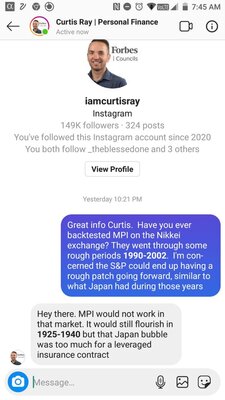krishawkins
New Member
- 8
You guys are right. I'm trying to work the math on this as if I'm the insurance company.
Let's say a client has a policy with a 270k value. I park that in treasuries and at the end of the year I will earn 1% on it, or $2700. Knowing that's what I will earn I go out and buy $2700 worth of call options. As it works out, one December 2021 at-the-money call option on the SPY etf is exactly $2700. So I buy one call option.
One year from now, the S&P 500 has gone up 10% and the SPY etf, which was at 370, is now at 407. This means our call option is worth $3700 at expiry.
Seeing that the market is up 10%, the client is expecting to be up 10% on his 270k account, or $27,000. Unfortunately our $3700 gain is not anywhere near that amount.
Even if we parked the 270k in mortgage backed securities yielding 3% we don't make near enough to buy enough call options to hit the target here.
We actually need to park that 270k in something yielding over 7% to earn enough to buy the equivalent number of call options.
Nothing remotely close to risk-free is yielding 7% right now. I don't see how this can work.
What am I missing here guys?
Let's say a client has a policy with a 270k value. I park that in treasuries and at the end of the year I will earn 1% on it, or $2700. Knowing that's what I will earn I go out and buy $2700 worth of call options. As it works out, one December 2021 at-the-money call option on the SPY etf is exactly $2700. So I buy one call option.
One year from now, the S&P 500 has gone up 10% and the SPY etf, which was at 370, is now at 407. This means our call option is worth $3700 at expiry.
Seeing that the market is up 10%, the client is expecting to be up 10% on his 270k account, or $27,000. Unfortunately our $3700 gain is not anywhere near that amount.
Even if we parked the 270k in mortgage backed securities yielding 3% we don't make near enough to buy enough call options to hit the target here.
We actually need to park that 270k in something yielding over 7% to earn enough to buy the equivalent number of call options.
Nothing remotely close to risk-free is yielding 7% right now. I don't see how this can work.
What am I missing here guys?

